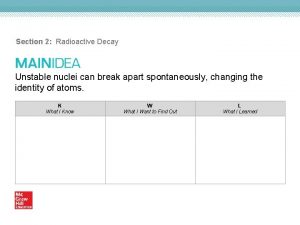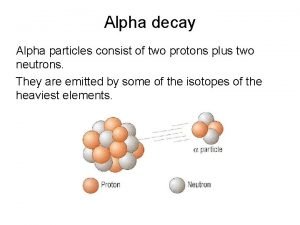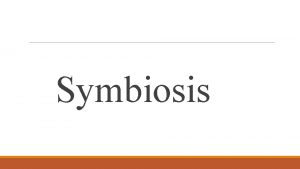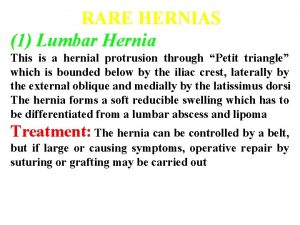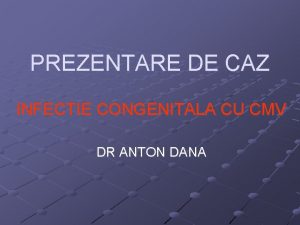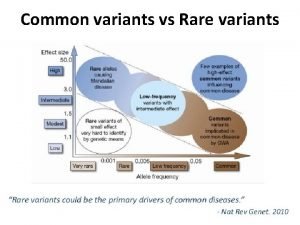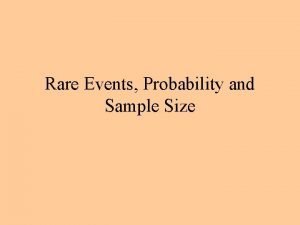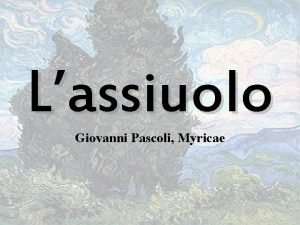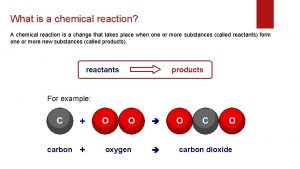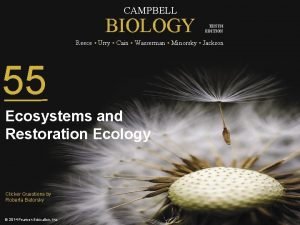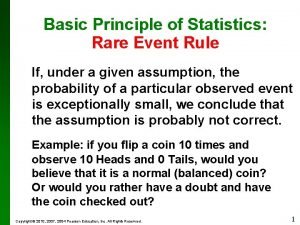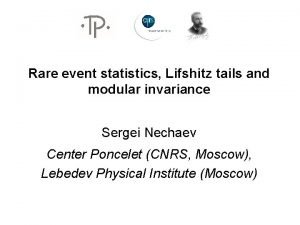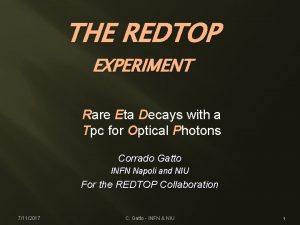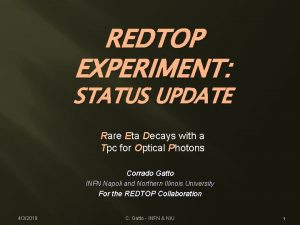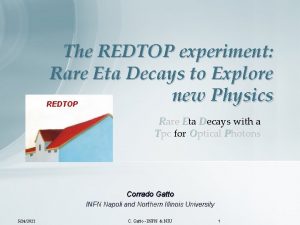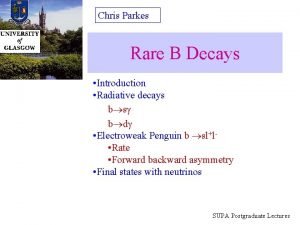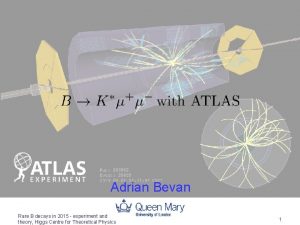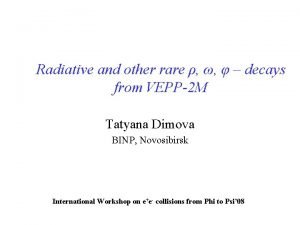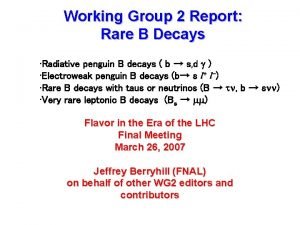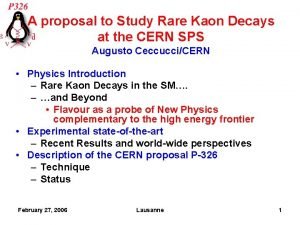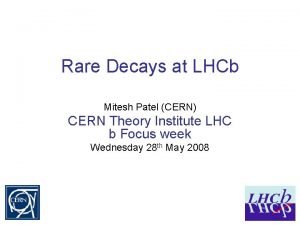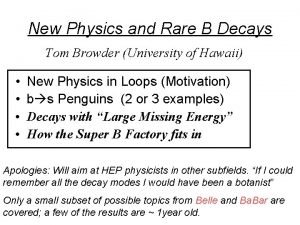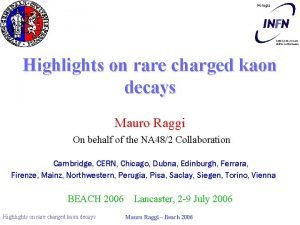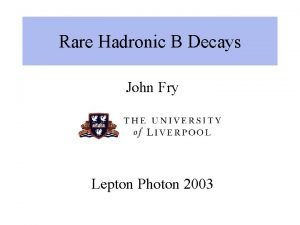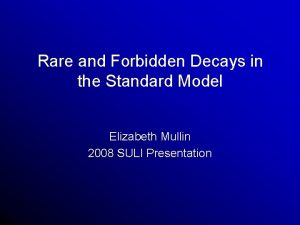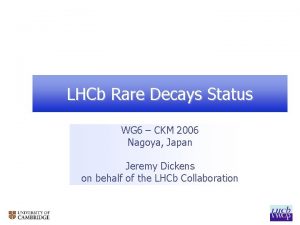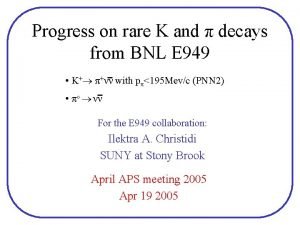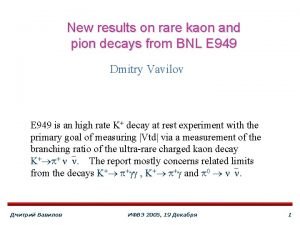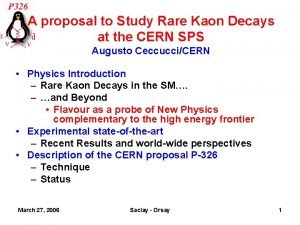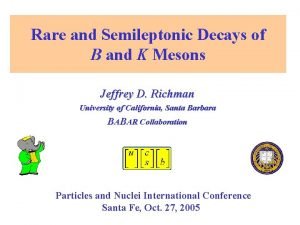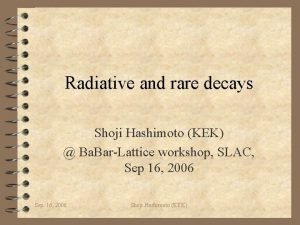THE REDTOP EXPERIMENT Rare Eta Decays with a























- Slides: 23

THE REDTOP EXPERIMENT Rare Eta Decays with a Tpc for Optical Photons Corrado Gatto INFN Napoli and NIU For the REDTOP Collaboration 10/27/2017 C. Gatto - INFN & NIU 1

REDTOP Experiment Key Points A near-4 p, fixed target detector sensitive to leptons and g’s Optical-TPC, Multiple-readout calorimeter, Active Muon Polarimeter (all novel technologies), Fiber tracker (new) Very fast (Cerenkov and scintillating light from organic only) to sustain event rates in next generation of High Intensity experiments Blind to barions Not overly expensive (<$40 M) A CW proton beam with user selectable energy All energies in 1. 5 -8 Ge. V available Extraction line from Delivery Ring to AP 50 Reuses components already available at Fermilab The experiment will yield 2 x 1013 h mesons/year and 2 x 1011 h’ mesons/year Multiple phases with different beam energy/PID - PIPII 10/27/2017 C. Gatto - INFN & NIU 2

Detecting BSM Physics with REDTOP (h/h’ factory) Assume a yield 2. 5 x 1013 h mesons/yr and 2 x 1011 h’ mesons/yr C, T, CP-violation q q q q po CP Violation via Dalitz plot mirror asymmetry: asymmetry h → p p CP Violation (Type I – P and T odd , C even): h-> 4 po → 8 g CP Violation (Type II - C and T odd , P even): even h → po l+l and h → 3 g Test of CP invariance via m longitudinal polarization: h → m+m – Test of CP invariance via g* polarization studies: h → p+p –e+e – and h → p+p –m+m – Test of CP invariance in angular correlation studies: h → m+m – e+ e – Test of T invariance via m transverse polarization: h → pom+m – and h → g m+m – CPT violation: m polariz. in h → p+m-n vs h → p-m+n and g polarization in h → g g + - New particles and forces searches meson searches (charged channel): h → po H with H→e e+e- and H→m+mq Dark photon searches: h → g A’ with A’ → l+lq Protophobic fifth force searches : h → g X 17 with X 17 → e+e q Scalar - leptophobic baryonic force searches : h → g B with B→ e+e- or B→ g po q Indirect searches for dark photons new gauge bosons and leptoquark: h → m+m- and h → e+eq Search for true muonium: h → g (m+m – )|2 M → g e+e – m q New Other discrete symmetry violations q q Lepton Flavor Violation: h → m+e – + c. c. Double lepton Flavor Violation: h → m+m+e – + c. c. Non-h/h’ based BSM Physics q q Dark photon and ALP searches in Drell-Yan processes: qqbar → A’/a → l+l– ALP’s searches in Primakoff processes: p Z → p Z a → l +l – (F. Kahlhoefer) Charged pion and kaon decays: p+ → m+n A’ → m+n e+e– and K+ → m+n A’ → m+n e+e– Neutral pion decay: po → g. A’ → ge+e– 10/27/2017 Other Precision Physics measurements q Proton q All radius anomaly: h → g m+m – vs h → g e+e- unseen leptonic decay mode of h / h ‘ (SM predicts 10 -6 - High precision studies on medium energy physics q Nuclear models 10 -9) q Chiral perturbation theory q Non-perturbative q Isospin breaking due to the u-d quark mass difference q Octet-singlet mixing angle q Electromagnetic C. Gatto - INFN-2) & NIU QCD transition form-factors (important input for g 3

Dark photon searches with 1013 h mesons h → g A’ → g + l+l- 10/27/2017 C. Gatto - INFN & NIU 4

REDTOP Constraints on a new baryonic force (courtesy of S. Tulin – U. York) REDTOP constraints at the level of BR(η’ → Bγ → π +π −πoγ) < 10− 8 REDTOP constraints at the level of BR(η → Bγ → πoγγ) < 3 × 10− 9 Based on 2. 5 x 1013 h meson produced and 1 x 1011 h‘ meson produced 10/27/2017 C. Gatto - INFN & NIU 5

Present h Samples A. Starostin - UCLA 9 Near future h Samples Glue. X@JLAB g 12 Ge. Vp → η p → neutrals (just started) JEF@JLAB g 12 Ge. Vp → η X → neutrals (recently approved) 4. 5 x 107/yr REDTOP@FNAL p 1. 9 Ge. VN → η pp (proposing) 2. 5 x 10 13/yr 10/27/2017 C. Gatto - INFN & NIU 3. 9 x 105/day 6

Accelerator complex for REDTOP Fermilab Option: AP 50 hall Use delivery ring and extract beam at AP 50 Decelerate the 8 Ge. V beam to desired energy. 10/27/2017 REDTOP C. Gatto - INFN & NIU 7

REDTOP detector in AP 50 B-field uniformity better than 4. 1% over the entire tracking volume J. Kilmer J. Rauch E. Barzi (Solenoid and yoke) (Many thanks to K. Krempetz, as well) 10/27/2017 C. Gatto - INFN & NIU 8

Acceleration Scheme (M. Syphers) Single p pulse from booster (£ 4 x 1012 p) injected in the DR (former debuncher in anti-p production at Tevatron) at fixed energy (8 Ge. V) Energy is removed by adding 1 -2 RF cavities identical to the one already planned for mu 2 e (J. Dey). Transitionless deceleration scheme by J. Johnstone (requires MADX confirmation) Spare RF cavities already existing (owned by mu 2 e and AD) Debunching occurs adiabatically inside the DR Slow extraction to REDTOP over ~40 seconds. The 270 o of betatron phase advance between the Mu 2 e Electrostatic Septum and REDTOP Lambertson is ideal for AP 50 extraction to the inside of the ring. A DEDICATED SEPTUM IS NOT REQUIRED Total time to decelerate-debunch-extract: 51 sec: duty cycle ~80% 9 C. Gatto - INFN & NIU 10/27/2017

The Experimental Apparatus Baseline detector q Beryllium or carbon fiber beam pipe, 10 cm dia x 1. 5 m long q 1 cm dia targets disk inside the pipe, spaced 10 cm apart q Multi-Aerogel around the beam pipe, 3 cm thick (for most muons and fast pions detection) q Optical-TPC 1 m diameter x 1. 5 m long q g-polarimeter in the rear section of the Optical-TPC (optional) q ADRIANO calorimeter: ~20 Xo (same as ORKA) or 64 cm deep. Inner and outer sections to accommodate the m-polarimeter in between q Total detector dimensions: 2. 2 m dia x 2. 7 m long q 2. 7 m long solenoid run at 0. 6 T (2. 4 m inner diameter) – E. Barzi helping with the design. Asymmetric yoke required q AP 50 cryogenics already in place q Potential interest from CERN-Geant 4 group on instrumenting the fwd and bkg detector regions (for G 4 validation of new hadronic models) 10/27/2017 C. Gatto - INFN & NIU 10

The REDTOP Detector (new) Optical TPC • • ~ 1 m x 1. 5 m CH 4 @ 1 Atm 5 x 105 Sipm/Lappd 98% coverage Beam & Target Aerogel Dual refractive index system Solenoid 0. 6 -0. 8 T 10 x Be targets • • 0. 33 mm thin Spaced 10 cm m-polarizer Active version (from TREK exp. ) ADRIANO-2 Calorimeter (tiles) • Scint. + heavy glass sandwich • 20 X 0 ( ~ 64 cm deep) • Triple-readout +PFA • 96% coverage 10/27/2017 C. Gatto - INFN & NIU Fiber tracker being investigated (for rejection of g-conversion and vertexing ) 11

2. 4 m REDTOP detector 2. 7 m 10/27/2017 1 m 1. 5 m C. Gatto - INFN & NIU 12

Changes - Issues – R&D required ADRIANO -> ADRIANO 2 (new) Add tiles directly coupled to SIPM DOE proposal submitted Sensors of OTPC Need to sustain >10 11 n/cm 2 (NEQ) LAPPD as possible choice (INCOM is the key) Trigger Need to recognize Cerenkov rings at L 1 L 0 from topological analysis of showers (PFA) Fiber tracker - LHCb style (new) Radiation damage Accelerator Physics Issues Transition Energy Resonant Extraction Vacuum 10/27/2017 C. Gatto - INFN & NIU 13

More details at: http: //redtop. fnal. gov 10/27/2017 C. Gatto - INFN & NIU 14

Status and Plans Nov. 2017: EOI to PAC (Fermilab for now) CY 2018 -2019 : LOI + proposal to PAC (Fermilab for now) CY 2018 -2020: Detector R&D (could be shorter) CY 2021: Detector construction + engineering run CY 2022: Start physics run for Phase-I Successive phases contingent to results of phase I, occupancy of the experimental hall and of the beam REDTOP 10/27/2017 C. Gatto - INFN & NIU 15

REDTOP Competitors 10/27/2017 C. Gatto - INFN & NIU 16

Backup slides 10/27/2017 C. Gatto - INFN & NIU 17

REDTOP Running Phases Phase I: h-factory. Goal is 2. 5 x 1013 h /yr Phase II: h ’-factory. Goal is ~ 1011 h’ /yr Tbeam: 3. 5 -4. 5 Ge. V (to be optimized) Power: 60 W Target: 10 x 0. 33 mm Be Phase III: Dark photons radiating form muons. Goal is > 1. 0 ´ 1013 m/yr (G. Krnjaic and Y. Kahn) Tbeam: 1< <3 Ge. V (to be optimized) Target: H 2 gas Phase IV: Muon Scattering Experiment. Goal is > 2. 0 ´ 1012 m/yr q q Tbeam: 0. 2< <0. 8 Ge. V (to be optimized) Muon muon yield: >1. 6 ´ 10 -8 m/p Target: 1 x 100 mm graphite Phase V: tagged REDTOP. Goal is > 2. 0 ´ 1013 h/yr q q Tbeam: 1. 8 -2. 1 Ge. V Power: 30 W Target: 10 x 0. 33 mm Be Tbeam: 1. 2 Ge. V (to be optimized) at PIP-II Muon muon yield: >1. 6 ´ 10 -8 m/p Target: tritium Phase VI: Rare Kaon Decays: K+ → p + n n Goal is > 1´ 1014 KOT/yr Tbeam: K+ from 8 Ge. V protons K+/p yield: 1 /13 (neglecting very soft pions – factor 1. 8 better than p@92 Ge. V) Target: primary (PT: for K production) + secondary (active: scintillating plastics) 10/27/2017 C. Gatto - INFN & NIU It could be made unnecessary by NA 62+ and JPARC 18

Tagged REDTOP at PIP-II The ultimate eta factory 10/27/2017 C. Gatto - INFN & NIU 19

Final Considerations • REDTOP physics case is strongly supported by theorists • A new accelerator facility available at hosting lab: • • Pre-PIP II detector: will shape the way for a new generation of experiments • • • an energy-variable, CW beam [1. 8 -8 Ge. V] All-new technology detectors Multiple years running plan: • Run I: 1. 8 Ge. V beam for h –factory • Run II: 3. 5 -4. 5 Ge. V for h’ –factory (after mu 2 e or before if time slot available) • Run III: with muon beam for a muon scattering experiment • Run IV: kaon beam for rare kaons decays studies Attractive to Universities and graduate students for quick physics and considerable detector R&D Total cost: < 40 M$ (depending on re-use of existing infrastructure) 10/27/2017 C. Gatto - INFN & NIU • 20

Summary & Prospects (I) The h meson is a fantastic laboratory for studying rare processes Existing world sample not sufficient for breaching into decays violating conservation laws REDTOP goal is to produce >2 x 1013 h mesons/yr in phase I Three more phases could extend the lifetime of the experiment considerably Three golden processes will be studied: q q CP Violation via Dalitz plot mirror asymmetry: asymmetry h → po p+p. Dark photon searches (charged channel): h → g A’ with A’→ e+e- and A’→m+m. New baryonic force searches (charged channel): h → g X with X→ e+e. Scalar meson searches (charged channel): h → po H with H→e+e- and H→m+m - Many other processes also within reach Fermilab is strongly preferred by the collaboration as hosting lab. BNL has, also, expressed considerable interest 10/27/2017 C. Gatto - INFN & NIU 21

REDTOP Key Points The experiment will yield 2 x 1013 h mesons/year and 2 x 1011 h’ mesons/year That is a consequence of the relatively large h production cross section (10 -20 mbar in the 2 Ge. V beam energy region) Requires a detector blind to protons and slow charged pions 4 p-detector can be used with beams of different energy and/or particles 10/27/2017 C. Gatto - INFN & NIU 22

Why the h meson is special? It is a Goldstone boson Symmetry constrains its QCD dynamics It is an eigenstate of the C, P, CP and G operators (very rare in nature): IG JPC =0+ 0 -+ It can be used to test C and CP invariance. All its additive quantum numbers are zero All its possible strong decays are forbidden in lowest order by P and CP invariance, G-parity conservation and isospin and charge symmetry invariance. EM decays are forbidden in lowest order by C invariance and angular momentum conservation The η decays are flavor-conserving reactions Its decays are not influenced by a change of flavor (as in K decays) and violations are “pure” It is a very narrow state (Gh=1. 3 Ke. V vs Gr=149 Me. V) Contributions from higher orders are enhanced by a factor of ~100, 000 Excellent for testing invariances Decays are free of SM backgrounds for new physics search h is an excellent laboratory to search for physics Beyond Standard 10/27/2017 C. Gatto. Model - INFN & NIU 23
 Nuclear decays and reactions section 2
Nuclear decays and reactions section 2 Uranium-238 alpha decay
Uranium-238 alpha decay Rare plaatsnamen nederland
Rare plaatsnamen nederland Shark and seal organism that is benefited
Shark and seal organism that is benefited Rare event rule for inferential statistics
Rare event rule for inferential statistics Rare consequential and directive
Rare consequential and directive What are the characteristics of nervous tissue
What are the characteristics of nervous tissue Rare hernias
Rare hernias Tout age porte ses fruits
Tout age porte ses fruits Normotrof
Normotrof Tiopurine
Tiopurine Types of autism
Types of autism Salvador dali och yoko ono
Salvador dali och yoko ono 3 principles of fingerprinting
3 principles of fingerprinting Rare events
Rare events Basic concepts of strategic management
Basic concepts of strategic management Facteur rare
Facteur rare La luna in pascoli
La luna in pascoli Slidetodoc.com
Slidetodoc.com Which group is alkali earth metals
Which group is alkali earth metals Why are big predatory animals rare
Why are big predatory animals rare Rare event rule statistics
Rare event rule statistics Rare event rule statistics
Rare event rule statistics L'eau en espagne une ressource rare sous pression carte
L'eau en espagne une ressource rare sous pression carte
